“Match programmes! Get your match programmes!”
It’s a shout that rings around football grounds up and down the country in Ireland and the United Kingdom. As synonymous with the matchday experience as the click of a turnstile, the smell of the burger van, the roar when the players emerge on to the pitch or the never-ending torrent of abuse directed at the referee by that fan a few seats down who just won’t shut up – the matchday programme is a part of the very fabric of the game.
But is it soon to be no more? On Friday the English Football League voted to amend regulations which made it a requirement for all 72 clubs to print a programme for every game. Those clubs are now no longer obliged to produce a programme at each match they play. The move comes after several of its members queried the requirement for clubs to offer a physical version of their product in an era of social media. Those clubs have reported a drop in sales in the current climate as fans move away from physical products and instead access the information online.
While this does not spell the immediate death of matchday programmes or anything like it, it does show that even the humble programme is not immune to the digital forces in the world which have already changed the face of music, media, literature and more. Record sales and book sales were initially hit hard by the digital era but have now recovered somewhat while newspaper sales continue to go the opposite way after the advent of online news. According to some Football League clubs the same is happening to programmes.
Mystique
Many will ask if a matchday programme is really needed anymore. Where the little magazine used to offer fans a voice from inside the club and hold a certain mystique with player profiles, interviews and manager’s notes, we now have the internet to provide all of those things and more. In the event of an exciting new signing the programme used to be the place to go to find out everything from the player’s favourite food to his mother’s name. Now you can watch hours of YouTube clips, scroll through his Twitter account and find out what he’s had for breakfast before the deal is even done.
But to look at the programme simply as a source of information to then be discarded is to get it wrong. For many people, it is so much more than that.
Last month the Irish Football Programme Club held its annual programme fair at St Andrew’s Resource Centre on Pearse Street in Dublin. The old hall was laid out with 13 stalls and more programmes than you could possibly look through in an afternoon. This is a collector’s paradise – the perfect place to go to unearth that rare gem you have been looking for.

Trade is busy with the customer base made up almost exclusively of men while some women sit and read newspapers, at this stage seemingly well used to their other half’s collecting habits. Some of the stalls must have close to a thousand programmes on them – each from the personal collection of the seller – and range from the likes of Shelbourne’s clash with Odense in the 2006 Intertoto Cup to a full collection of programmes from every home and away match – including reserve team games – that Manchester United played in their 1999 treble-winning season, complete with a number of newspapers from the time. The starting price for all of that is €1,000 and the seller reckons it could go for up to €2,000 online.
The fair has the rough and tumble feeling of a bric-a-brac sale but the items are treated like the most precious of diamonds. Most are held in ring binders, individually kept in plastic pockets and treated with utmost care.
“I started going to see Shamrock Rovers in Milltown in the 50s,” says John, secretary of the Irish Football Programme Club.
“The old Rovers programmes were eight pages and they were all football with tiny ads. They were cheap – three old pence – and most clubs like Shelbourne, Bohs, Drumcondra all produced programmes in that era so that’s where it would have started.
Dark side
“I’d be up in the thousands now. You’d want to have lots of room to store them – I’m okay in that I have a garage and an attic but even that’s getting full.”
Like records, books, magazines, comics, newspapers and so on, there’s something great about holding a physical programme that you just can’t get from looking at a website. The feel between your fingers, the smell of the pages – there are some things a screen just can’t offer. Looking through some of the old programmes at the fair gives a real sense of the feeling around the club at the time – none more so than the two collections on offer of Manchester United programmes, one from before and one from after the Munich air disaster in 1958. From one programme to the next, you can clearly see a sense of joy and excitement turning to shock and mourning.

But even programme collecting has a dark side, as John explains.
“If a club wouldn’t print a programme – as many European clubs don’t – some lads would dream up their own one, photocopy 100 of them and sell them to collectors. They’re putting them up on eBay or wherever and lads are falling for them. Leeds played Dynamo Kiev at one stage and a Leeds collector told us that he went up to this hotel and there were about 10 or 12 fellas all with their versions of the programme laid out on the table selling them off. We’d call them pirate programmes.”
Back at the fair, the Programme of the Year awards are being handed out with Shamrock Rovers the winners in the Premier Division and Waterford in the First Division.
One stall has just sold a programme from the 1999 Champions League final signed by Alex Ferguson and four players for €90. It doesn't matter so much if you were at the game or not, collections need to be completed. Like any form of collecting – from art to comic books – it's the sense of satisfaction in just having the item that outstrips all else.
Rarer
But for how long? The Irish Football Programme Club has between 100-150 members but they’re not getting any younger. If clubs start to limit the number of programmes they produce the items themselves will become rarer and collections will become smaller. So where will programme collecting be in 10 or 15 years?
“It won’t be there, it just won’t be there,” says John. “I think it’ll only be the bigger games. Bigger clubs will still produce programmes because they have a hardcore following but they will limit the numbers.
“There’s still a fair hardcore of programme collectors but it’s more the older crowd than a younger crowd. Kids don’t really collect stamps anymore or coins – there’s no real hard copy people are collecting anymore.”
But there is cause for optimism. The invention of e-readers led to a rise in sales of physical books while record sales grew again by 22 per cent worldwide last year. While match programmes may be in decline at the current time, a future renaissance is not out of the question – lots of things come in and out of fashion, after all. With that in mind, it was recently announced that – later this month – Roy of the Rovers is coming back to life after 17 years in the wilderness.
All hope is not lost.











